Spain E-commerce Market Size
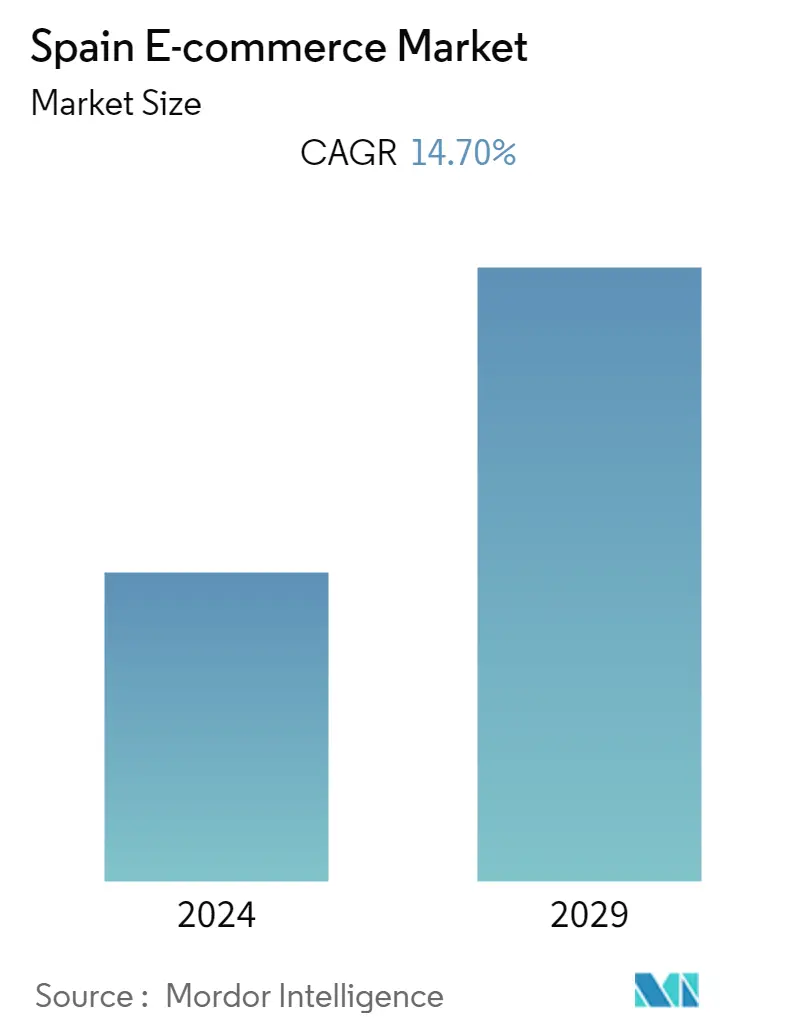
| Study Period | 2019 - 2029 |
| Base Year For Estimation | 2023 |
| Forecast Data Period | 2024 - 2029 |
| Historical Data Period | 2019 - 2022 |
| CAGR | 14.70 % |
| Market Concentration | Medium |
Major Players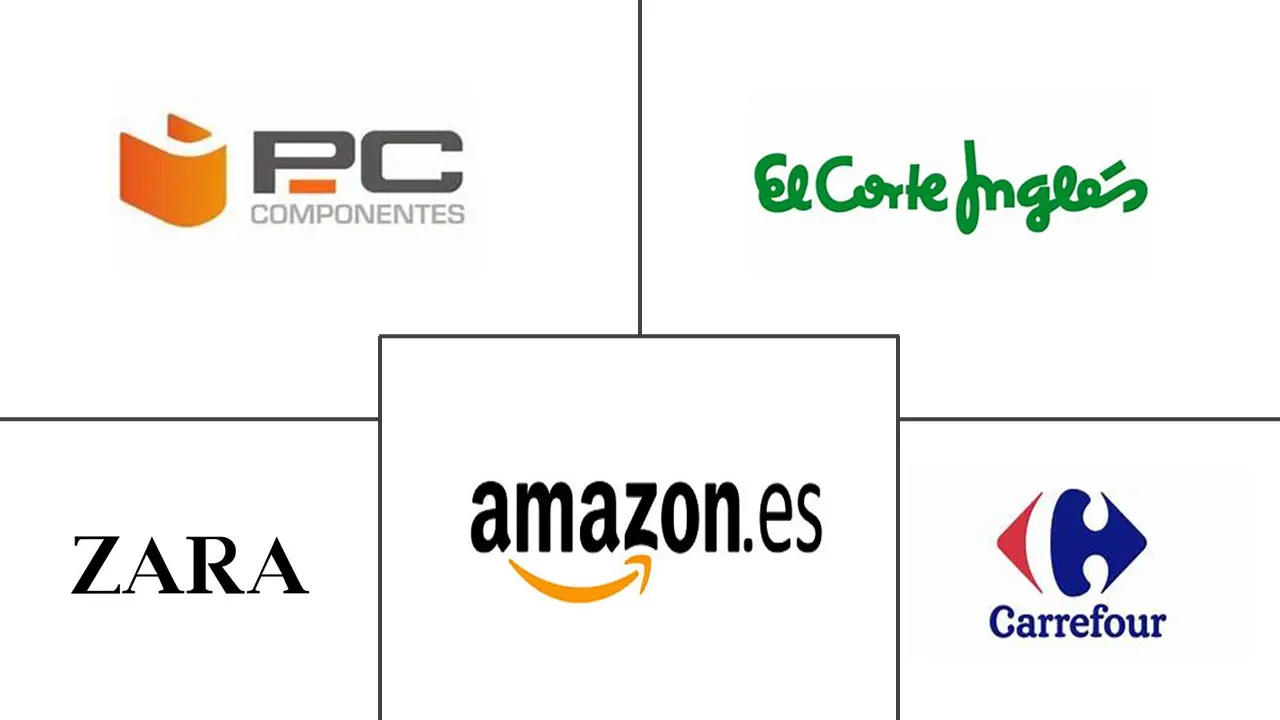
*Disclaimer: Major Players sorted in no particular order |
Spain E-commerce Market Analysis
Spain's E-commerce Market is expected to register a CAGR above 14.7% during the forecast period, 2022-2027. Spain is one of Europe's largest markets for Fashion, Electronics & Media segments in revenue. This market is primarily driven by rising Internet and smartphone penetration, increasing reliance on social media to promote e-commerce platforms, expanding omnichannel business models, and introducing new payment modes.
- The top players in Spain's e-commerce market include various brands. This consists of the usual American giant like Amazon and eBay and some European heavyweights like Carrefour and Media Marketplace, which provides several local brands, making Spain one of the more diverse e-commerce markets.
- The market is expected to grow rapidly in the coming years Because of rising internet penetration. The use of smartphones and technological awareness among users has increased dramatically over the last decade, positively impacting the global market growth. Furthermore, advances in connectivity and high-speed internet availability, such as 3G, 4G, and 5G, significantly impact market growth.
- Correos is the most commonly offered delivery service provider among online stores in Spain. Even before inquiring about which service people use to transport their goods, 28 % named Correos as one of their providers. Furthermore, SEUR and UPS are among the top three shipping service providers offered by online retailers in Spain, with 21% and 18%, respectively.
- El Corte Inglés, eBay, Amazon, Mil Anuncios, Segunda Mano, Lets Bonus, Groupon, Bing, eBay, and Groupalia are popular online stores in Spain. With net e-commerce sales of US$ 4,416 million in 2020 generated in Spain, Amazon.es leads the Spanish e-commerce market, followed by Elcorteingles.es with US$ 1,862 million in 2020.
- COVID-19 has had a significant impact on the Spanish e-commerce market. E-commerce businesses faced many significant challenges, including disrupted supply chains, limited operations due to the lockdown, inventory management, and an overall lack of employees. In response to the COVID-19 pandemic, governments worldwide have imposed social distancing measures or temporarily closed non-essential businesses and taken other steps. As a result, e-commerce sales have increased. The pandemic has increased the use of online platforms in the Spain market.
- The COVID-19 pandemic has transformed Spanish consumer lifestyles and purchasing habits, allowing them to shift from traditional retail stores to online portals for goods and services. Many new omnichannel initiatives were launched in the first six months of 2020, resulting in smaller stores' closure and integration into more prominent format locations. Using the Zara App, the company launched a 'Store Mode,' allowing 25 stores across Spain to offer new features to customers, such as ordered products being ready for pick up within 30 minutes.
Spain E-commerce Market Trends
This section covers the major market trends shaping the Spain E-commerce Market according to our research experts:
Increasing smartphone penetration
- Global online retail sales totaled $4.9 trillion. It is expected to grow by more than 50% over the next four years. Mobile commerce continues to grow; by 2021, mobile users will have generated $3.56 trillion in retail e-commerce sales. For years, e-commerce sites have optimized the mobile experience to increase online sales.
- Spain offers excellent robotics and automation subsectors opportunities, where US exporters can compete. Spain is the world's tenth-largest market and Europe's fourth. The number of new robot installations in Spain reached 5,266 units in 2018 and is expected to rise in the coming years. Companies in Spain employ 160 robots per 100,000 employees. Robotic automation implementation processes are currently used by 53% of Spanish businesses.
- With the introduction of Amazon's Prime service, logistics has become a critical differentiator for Spanish sellers in the Spanish eCommerce market. Second, Spain has one of the highest smartphone penetration rates in Europe, fueling eCommerce growth. Finally, as the market grows, the need for industry participants to integrate analytics, artificial intelligence, big data, and chatbots becomes more critical.
- The new EU VAT rules, which go into implication on July 1, 2021, and for EU Authorized Representatives on July 16, 2021, would also affect everyone in the eCommerce supply chain, from online sellers and marketplaces/platforms both inside and outside the EU to postal operators and couriers, customs and tax administrations, and to the end-user/consumer.
- Another vital aspect of e-commerce is digital marketing. According to the IAB Spain Digital Ad Spending Report, digital ad spending in 2020 is expected to be $3.4 billion (3 billion euros). It is one of only a few European markets that has experienced negative growth this year (-3.8 percent). The main in-country eCommerce events include eShow Madrid, held in conjunction with the event Technology for Marketing -TFM in Madrid.
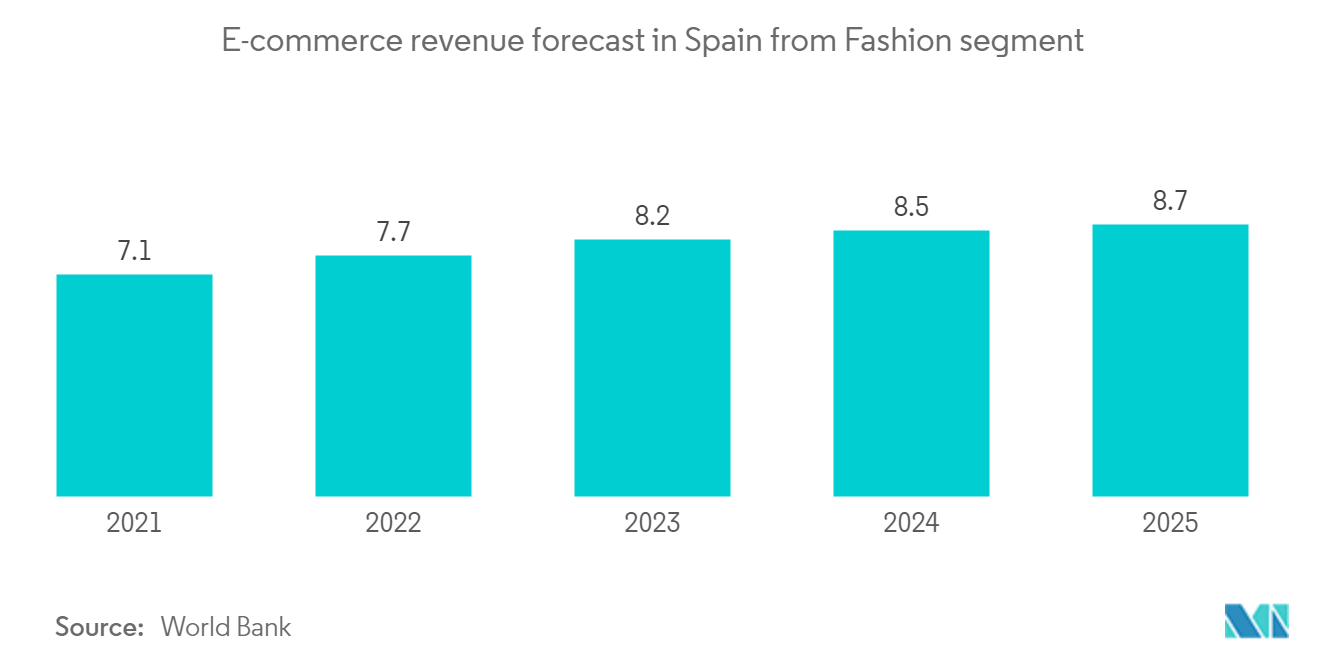
Growth of B2C E-commerce in Spain
- Tourism in Spain is integral to their economy, and citizens and international visitors are encouraged to book flights and accommodation after the COVID-19 pandemic would be vital to Spain's e-commerce growth. The government has created a US$964.4 million loan scheme to improve the Spanish tourism industry's e-commerce infrastructure. Further, in Spain, Mid-career citizens have embraced e-commerce faster than younger ones, likely due to higher disposable income. The 35-44 age group has more online shoppers than Spain's 45-54 age group.
- Mobile commerce had a more positive outlook than the overall e-commerce market, set to expand at a compound annual growth rate of 17.3 % to 2023, where it will generate EUR39.5 billion in sales. Mobile commerce growth is backed by good smartphone penetration (at 72.5 percent and rising) and a tendency to shop using portable devices. Desktop computers are not the top three preferred ways to access online shopping in Spain. Laptops (first), smartphones (second), and tablets (third) dominate instead. Enabling mobile commerce sites to work seamlessly with voice assistant technology may be an important route to cracking the Spanish market. The technology is a key feature of Spain's digital culture, with half of Spaniards already using a voice assistant; Google Assistant is the most popular, followed by Apple's Siri.
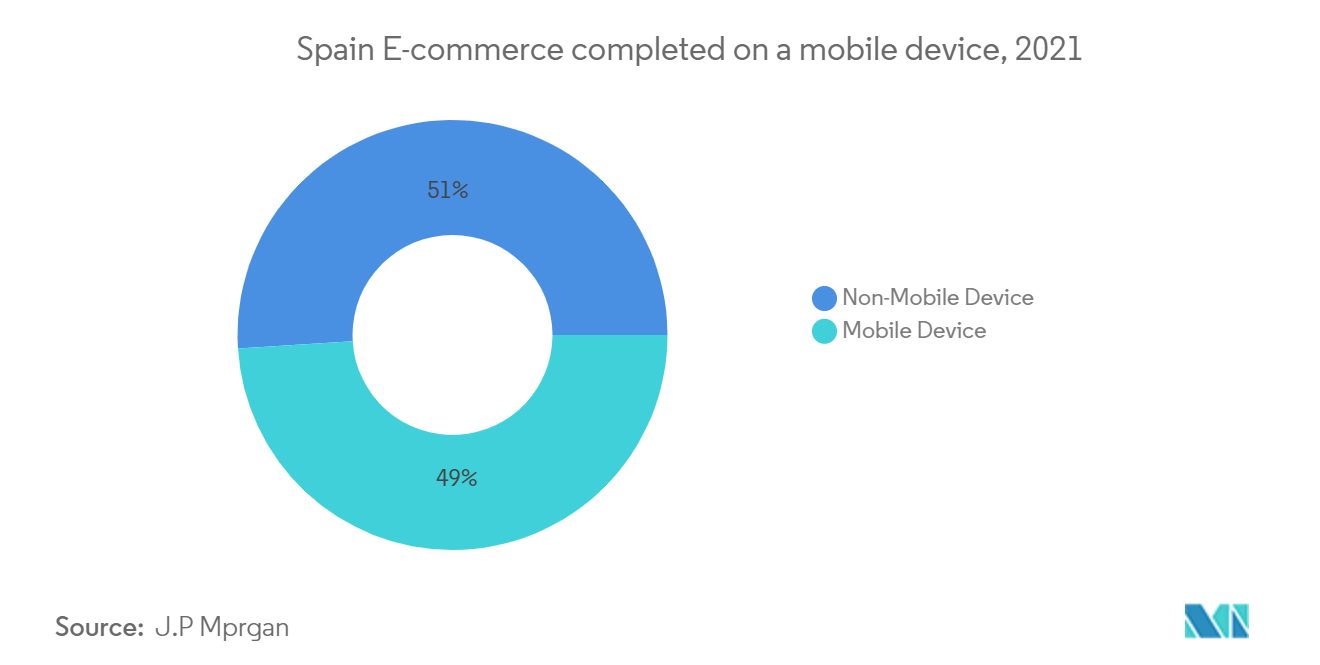
Spain E-commerce Industry Overview
The Spanish e-commerce market is highly fragmented due to several players of various sizes in a highly competitive market. This market is expected to see several mergers, acquisitions, and partnerships as companies continue to invest in offsetting the current strategic slowdowns.
- April 2022- IT Genetics, a wholly Romanian-owned company and one of the most critical hardware and software solution providers in the DC/POS (data collection and point of sale) market, is expanding its international presence by opening its third international office, this time in Madrid, Spain.
- April 2022- MOCAPP, Romania's largest Influencer Marketing platform, has launched a new technology solution for international eCommerce players. The new L!NK app employs a proprietary algorithm that scans online store customer bases anonymously. It enables them to determine which of their customers are active on Social Media and can be most effectively involved in promotions, loyalty, affiliation, and sales. Promotions, loyalty, affiliation, and sales.
Spain E-commerce Market Leaders
-
Amazon Spain
-
El Corte Ingles
-
PC Componentes
-
Carrefour Spain
*Disclaimer: Major Players sorted in no particular order
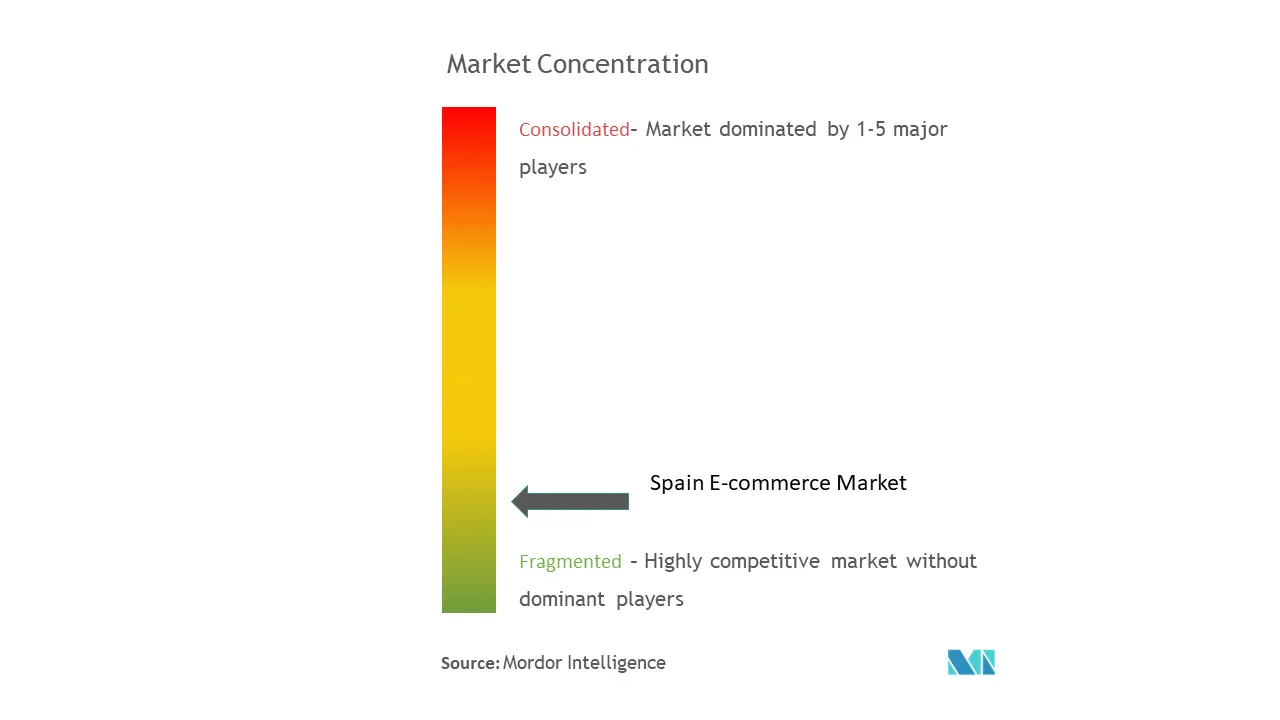
Spain E-commerce Market News
- May 2022- Artificial intelligence (AI) has changed the pattern of fashion business strategies by artificial intelligence (AI). There are numerous ways in which artificial intelligence has aided the fashion industry. This includes recognizing product features using predictive analytics and computer vision. The use of AI in the fashion industry has grown, primarily to analyze search behaviors and provide similar product recommendations based on consumer preferences.
- April 2022- Veepee is extending its service to its members in Spain. It is a French online shop and website that sells brand overstock to its members exclusively through flash sales. Re-Cycle is an initiative aligned with Veepee's DNA and the principle of circularity, as it allows us to offer a new solution to brands facing product life cycle challenges.
- April 2022- According to local newspaper Kleine Zeitung, Media-Markt, Europe's largest electronics retailer, has decided to install Bitcoin ATMs at twelve branches across Austria. Bitcoin will be available for purchase at Kurant vending machines. Kurant, a Confinity spin-off founded in 2017, currently operates 200 Bitcoin ATMs in Austria, Spain, Greece, and Germany.
- November 2021- Alibaba's e-commerce platform for selling to markets outside of China, AliExpress, has added a supermarket service to its Spanish application. In collaboration with the internet operator Lola Market, this is the world's first market to do so. AliExpress enters this market so its customers can purchase thousands of products from Spain's eleven supermarket chains and thirteen food markets.
Spain E-commerce Market Report - Table of Contents
1. INTRODUCTION
- 1.1 Study Assumptions and Market Definition
2. RESEARCH METHODOLOGY
3. EXECUTIVE SUMMARY
4. MARKET INSIGHTS
- 4.1 Market Overview
-
4.2 Industry Attractiveness-Porter's Five Forces Analysis
- 4.2.1 Bargaining Power of Suppliers
- 4.2.2 Bargaining Power of Buyers/Consumers
- 4.2.3 Threat of New Entrants
- 4.2.4 Threat of Substitute Products
- 4.2.5 Intensity of Competitive Rivalry
- 4.3 Key market trends and share of e-commerce of total Retail sector
- 4.4 Impact of COVID-19 on the e-commerce sales
5. MARKET DYNAMICS
- 5.1 Market Drivers
- 5.2 Rising number of online stores and online marketplaces
- 5.3 Rising Adoption of E-Commerce Business
- 5.4 Penetration of Internet and Smartphone Usage
- 5.5 Market Challenges
- 5.6 Analysis of key demographic trends and patterns related to the e-commerce industry in Spain (Coverage to include Population, Internet Penetration, e-commerce Penetration, Age & Income, etc.)
- 5.7 Analysis of the critical modes of transaction in the e-commerce industry in Spain (coverage to include prevalent methods of payment such as cash, card, bank transfer, wallets, etc.)
- 5.8 Analysis of cross-border e-commerce industry in Spain (Current market value of cross-border & key trends)
- 5.9 Current positioning of Spain in the e-commerce industry in Europe
6. MARKET SEGMENTATION
-
6.1 By B2C e-commerce
- 6.1.1 Market size (GMV) for the period of 2017-2027
- 6.1.2 Market Segmentation - by Application
- 6.1.2.1 Beauty & Personal Care
- 6.1.2.2 Consumer Electronics
- 6.1.2.3 Fashion & Apparel
- 6.1.2.4 Food & Beverage
- 6.1.2.5 Furniture & Home
- 6.1.2.6 Others (Toys, DIY, Media, etc.)
- 6.2 By B2B e-commerce
- 6.3 Market size for the period of 2017-2027
7. COMPETITIVE LANDSCAPE
-
7.1 Company Profiles
- 7.1.1 Amazon Spain
- 7.1.2 Milanuncios
- 7.1.3 El Corte Ingles
- 7.1.4 Ali Express
- 7.1.5 eBay Spain
- 7.1.6 Carrefour Spain
- 7.1.7 Media Markt Spain
- 7.1.8 PC Componentes
- 7.1.9 Decathlon Spain
- 7.1.10 Leroy Merlin
- *List Not Exhaustive
8. INVESTMENT ANALYSIS
9. FUTURE OUTLOOK OF THE MARKET
** Subject To AvailablitySpain E-commerce Industry Segmentation
E-commerce is the purchasing and selling of products and services over the Internet. It is conducted over computers, mobiles, tablets, and other smart devices. There are primarily two types of e-commerce, including Business-to-Consumer (B2C) and Business-to-Business (B2B).
The Spain E-commerce Market is segmented into B2C E-Commerce (Beauty and Personal Care, Consumer Electronics, Fashion and Apparel, Food and Beverage, Furniture and Home), and B2B E-Commerce.
| By B2C e-commerce | Market size (GMV) for the period of 2017-2027 | |
| Market Segmentation - by Application | Beauty & Personal Care | |
| Consumer Electronics | ||
| Fashion & Apparel | ||
| Food & Beverage | ||
| Furniture & Home | ||
| Others (Toys, DIY, Media, etc.) |
Spain E-commerce Market Research FAQs
What is the current Spain E-commerce Market size?
The Spain E-commerce Market is projected to register a CAGR of 14.70% during the forecast period (2024-2029)
Who are the key players in Spain E-commerce Market?
Amazon Spain, El Corte Ingles, PC Componentes and Carrefour Spain are the major companies operating in the Spain E-commerce Market.
What years does this Spain E-commerce Market cover?
The report covers the Spain E-commerce Market historical market size for years: 2019, 2020, 2021, 2022 and 2023. The report also forecasts the Spain E-commerce Market size for years: 2024, 2025, 2026, 2027, 2028 and 2029.
What are the growth opportunities in the Spain E-commerce Market?
The growth opportunities in the Spain E-commerce Market are a) Leveraging social media platforms for marketing and advertising can be a powerful tool to reach online shoppers in Spain b) Investments in efficient delivery networks and warehousing infrastructure can enhance customer satisfaction and support e-commerce growth
E-commerce in Spain Industry Report
The Spain ecommerce market size is set for substantial growth, fueled by increased internet and smartphone penetration, enhancing access to online shopping platforms. The ecommerce industry in Spain, characterized by its competitiveness and fragmentation, includes both local and international players addressing diverse consumer needs in key segments such as fashion, electronics, and media. These segments are significant revenue contributors, supported by advanced technological infrastructure like high-speed internet and mobile connectivity, ensuring a smooth shopping experience. The industry is also transitioning towards omnichannel retailing and adopting innovative payment solutions, boosting consumer convenience and trust in online transactions. Moreover, the integration of AI and big data continues to evolve the industry landscape, promising to revolutionize the shopping experience and propel future growth. For detailed statistics on the market share, size, revenue growth rate, and a forecast outlook of the ecommerce industry in Spain, access a free report PDF download from Mordor Intelligence™ Industry Reports. This comprehensive analysis offers an historical overview and insights into the dynamic ecommerce market in Spain, highlighting significant opportunities supported by technological advancements and shifting consumer behaviors.



